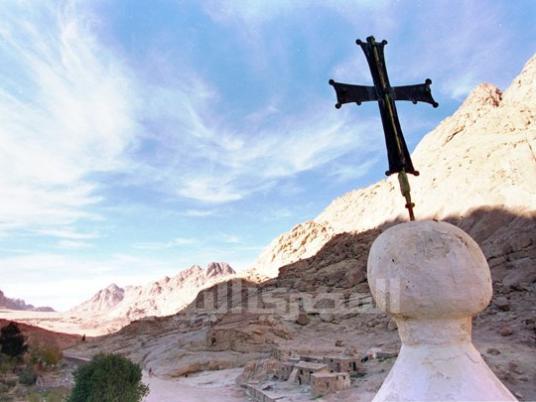History is rife with instances in which art was used to deliver a specific message or set of beliefs; one of the most fascinating examples is Coptic iconography – an art form that first came to life in ancient Egypt.
“The Eternal Eye,” an exhibition of work by Egyptian iconographer Magdy William, presents a unique look into the dual nature of Coptic icons, as works of art and as historical, religious artifacts, recounting tales from the Bible.
The exhibition is held at St. John’s church in Maadi. Yet it is “not a religious service," according to curator Jessica Wright, but an exhibition held in a location “constructed to best serve the icons.” Needless to say the atmosphere is still one of piety, but not preachiness. The exhibition is more characterized by the beguiling ways in which art can become a vessel for spirituality.
“Originally, icons were created to be placed in churches for illiterate worshippers,” explains Wright. “They were visual narratives of stories from the scriptures, so that people who couldn’t read would still be able to understand, and learn about, their own faith.”
Wright explains that while people are more literate nowadays, icons continue to hold a significant place in the “church experience.”
Traditionally, Coptic icons are painted on wooden boards with a combination of materials including gesso, tempura and gold-leaf. They come in a variety of sizes, although not too large as most are meant to be portable. “A lot of churches will have wall art or murals,” says Wright. “But icons are unique in that they can also be found in people’s homes.”
William started off his artistic career depicting an entirely different sort of icon. “I painted movie posters,” he recalls, “at a time when posters were handmade, and then copied. Today they just use photography, but back then, studios would hire artists to produce a film’s promotional material.”
He soon found himself drawn to Coptic art, which he says has a “unique quality. It produces a certain effect for worshippers and believers, it creates a spiritual atmosphere, one that is conducive to penitence and prayer, which I thought was very interesting.”
Another aspect that William finds fascinating is its history. “Coptic art is an extension of Pharaonic art,” he says, citing the similarities in both method and materials. “It’s very similar to the way ancient Egyptians used to present their dead." Ancient Egyptian rituals included decorating coffin lids with a life-size image of the deceased at the age of 25. “Twenty-five was viewed as the ideal age, and that image would be painted onto the lid of the coffin, so that when it’s time for the soul to return to the body, it’ll be able to easily identify it, based on the coffin,” says William. “The style of these drawings, and the material used, are identical to those used by modern-day iconographers. Except for the gold. Ancient Egyptians poured actual gold onto their coffins. I just use gold-leaf.”
The story-telling nature of Coptic art also interests William; he sees it as the main challenge in the creation of icons, which traditionally represent tales from the Bible or Holy Scriptures. “When working on an icon,” he says, “you have to research the story which you’re depicting, and you have to find a way to include all the essential elements from the story into that one single icon.”
“Iconography is an art form that is built on storytelling,” says William. “It’s decorative, but not exclusively. It also preaches certain morals and values through the story being retold.”
When it comes to selecting stories, William shrugs: “Usually, the churches will ask for certain scenes, or stories. It’s up to the artist to find ways to creatively tell a story that’s already been told countless times.” When the church fails to specify, William makes his decision based on what he believes to be “the most suitable choice for the location.”
He insists though that “icons aren’t made just for churches.”
“Iconography started in Egypt, and spread to the rest of the world, and that makes me proud. I was the first iconographer here to include the pyramids in his work,” he boasts. “And when people would ask me why there were pyramids in my icons, I would tell them ‘because iconography is an Egyptian art, and the pyramids are a symbol of Egypt.’”
Coptic art all but died out in the 18th and 19th centuries, when the previously hidden treasures of Pharaonic Egypt were uncovered by wave after wave of foreign explorers and archaeologists who were more interested in ancient Egyptians than the work of the Copts who came after them. Churches that were previously temples were torn down and desecrated so that archeologists could get to the original architecture. For several decades, Egypt’s cache of Coptic art was literally dismantled and forgotten in favor of their forefathers’ buried treasures.
“This country has gone through some tough times, and, by the time I began to study iconography, it was almost an entirely forgotten art, more heavily practiced in places like Greece and Russia,” says William. “But the world is a small place, and we sometimes forget that. Sometimes it’s easy to take back what you lost; to learn it from the people who learned it from you.”
William speaks from personal experience, having learned the art from Isaac Fanous, the “master of Coptic art” credited for leading its revival in Egypt after having traveled to Russia to learn the basics. Fanous passed on his knowledge to William, who has had his own icons displayed in churches and museums around the world, including in Sweden, Norway, Australia and New York. William’s icons are also on permanent display in some churches in Egypt, although he claims not to remember their names. “One of the churches was in Sohag,” he says. “And there was one in Fayoum, I think.”
While William may display a nonchalance about his work, others would argue that, at a time of political – and subsequently, cultural – instability and increasing sectarian strife, his efforts are indispensable in preserving an artform that has faded in and out of public consciousness throughout the nation’s history.
“This exhibition is about more than Coptic art,” says Wright. “It’s about honoring a part of Egypt that dates back to the beginning of its history, and it’s a way to express our hope that, as this country moves forward, all voices will be heard.”
“The Eternal Eye” will run until 26 October at St. John’s Church, off the corner of Port Said Street and Road 17 in Maadi. For more information call 02 235 83085, or visit www.maadichurch.org




